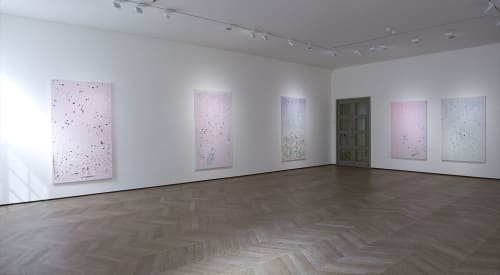Vigo Gallery
Kadar Brock makes iconic work that manifests universal processes. Every artist is confronted with the prospect of risking a work, of self-selection, and of self-editing, and most artists have destroyed a work to repaint altogether or to attempt to delete it from their personal history.
The works in this show have been made and then remade. They have lived two different but related consecutive lives. Paintings from earlier in Kadar's career are dismantled from their stretchers and scraped back -the artist sanding through the layers of the previous paintings whist reintroducing a veil of white powderyness. Chalky household emulsion combines with effervescent hangover cure Neon spray paint to offer hovering seductive surfaces. They feel very much of the moment whilst at the same time revealing past decisions, thoughts and the passing of time.
Brock appears to reference Manzoni, Fontana and other historical artists whilst effervescing a sort of immediate aesthetic contemporary punkishness. But one can also imagine the paintings relating to ancient ruins bitten by centuries of wear, or archeological digs and craters that could have resulted from cosmological explosions. Like the surface of some funky planet yet to be discovered they show us some of the history and scars of their creation.
The starting point for what we see in this show was a shift in Brock's relationship with mark making about four years ago. Prior to that, the work was concerned with the translation of subjective content into the mark. Stemming from Romanticism, which supposes that one's intentions and feelings automatically translate into one's actions, the extension of these beliefs runs into art via expressionism, early abstraction, and abstract expressionism. (An alternative parallel is the pseudo-science of graphology that burgeoned at the beginning of the 20th century, which used handwriting as a way to psychologically analyze a person.) The hope with doing this was to talk about similar Romantic things - re-contextualizing the sublime, points of oneness and interconnectedness, -contemplative practice. However he realized that although it was his strongest desire to connect with people about these things, it just wasn't happening.
"So I went about dismantling it, trying to pressure it and it's accompanying marks, and these works are another step (I can't say the end step) of that process. What they are, is in fact the physical deconstruction of those earlier paintings, and vis a vis those beliefs. But something happens through that ritual, I can never quite really get rid of anything. There's always these ghosts and layers. And really what we are left with is simply the embodiment of a desire to self-erase, and the beautiful loss of belief structures to the passage of time…" Brock holds a spiritual interest in self-reflection and deconstruction and these paintings are the physical manifestation of this process.

